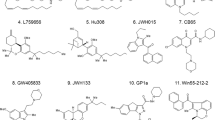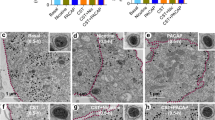Abstract
This paper investigated the role of acetylcholine (ACh) in physiological regulation of amylase secretion in avian exocrine pancreas. In the isolated duck pancreatic acini, ACh dose dependently stimulated amylase secretion, with a maximal effective concentration at 10 μM. The cAMP-mobilizing compounds forskolin, vasoactive intestinal peptide (VIP)/pituitary adenylate cyclase activating peptide (PACAP) receptor (VPAC) agonists PACAP-38 and PACAP-27 had no effect on the dose–response curve. ACh dose dependently induced increases in cytosolic Ca2+ concentration ([Ca2+] c ), with increasing concentrations transforming oscillations into plateau increases. Forskolin (10 μM), PACAP-38 (1 nM), PACAP-27 (1 nM), or VIP (10 nM) alone did not stimulate [Ca2+] c increase; neither did they modulate ACh-induced oscillations, nor made ACh low concentration effective. These data indicate that ACh-stimulated zymogen secretion in duck pancreatic acinar cells is not subject to modulation from the cAMP signaling pathway; whereas it has been widely reported in the rodents that ACh-stimulated exocrine pancreatic secretion is significantly enhanced by cAMP-mobilizing agents. This makes the duck exocrine pancreas unique in that cholinergic stimulus-secretion coupling is not subject to cAMP regulation.







Similar content being viewed by others
References
An YP, Xiao R, Cui H, Cui ZJ (2003) Selective activation by photodynamic action of cholecystokinin receptor in the freshly isolated rat pancreatic acini. Br J Pharmacol 139:872–880. doi:10.1038/sj.bjp.0705295
Arimura A (2007) PACAP: the road to discovery. Peptides 28:1617–1619. doi:10.1016/j.peptides.2007.06.006
Burnham DB, McChesney DJ, Thurston KC, Williams JA (1984) Interaction of cholecystokinin and vasoactive intestinal polypeptide on function of mouse pancreatic acini in vitro. J Physiol 349:475–482
Camello PJ, Wisdom D, Singh J, Francis LP, Salido GM (1993) Effect of phorbol ester on vagal stimulation and acetylcholine-evoked exocrine pancreatic secretion and cytosolic free calcium in the rat. Arch Int Physiol Biochim Biophys 101:133–139. doi:10.3109/13813459309008882
Campos-Toimil M, Edwardson JM, Thomas P (2000) Real-time studies of zymogen granule exocytosis in intact rat pancreatic acinar cells. J Physiol 528:317–326. doi:10.1111/j.1469-7793.2000.00317.x
Cancela JM (2001) Specific Ca2+ signaling evoked by cholecystokinin and acetylcholine: the roles of NAADP, cADPR, and IP3. Annu Rev Physiol 63:99–117. doi:10.1146/annurev.physiol.63.1.99
Cancela JM, Gerasimenko OV, Gerasimenko JV, Tepikin AV, Petersen OH (2000) Two different but converging messenger pathways to intracellular Ca2+ release: the roles of nicotinic acid adenine dinucleotide phosphate, cyclic ADP-ribose and inositol trisphosphate. EMBO J 19:2549–2557. doi:10.1093/emboj/19.11.2549
Chey WY, Chang T (2001) Neural hormonal regulation of exocrine pancreatic secretion. Pancreatology 1:320–335. doi:10.1159/000055831
Cui ZJ, Kanno T (1997) Photodynamic triggering of calcium oscillation in the isolated rat pancreatic acini. J Physiol 504:47–55. doi:10.1111/j.1469-7793.1997.047bf.x
Dimaline R, Dockray GJ (1979) Potent stimulation of the avian exocrine pancreas by porcine and chicken vasoactive intestinal peptide. J Physiol 294:153–163
Fujii T, Yamada S, Yamaguchi N, Fujimoto K, Suzuki T, Kawashima K (1995) Species differences in the concentration of acetylcholine, a neurotransmitter, in whole blood and plasma. Neurosci Lett 201:207–210. doi:10.1016/0304-3940(95)12180-3
Gautam D, Han SJ, Heard TS, Cui Y, Miller G, Bloodworth L, Wess J (2005) Cholinergic stimulation of amylase secretion from pancreatic acinar cells studied with muscarinic acetylcholine receptor mutant mice. J Pharmacol Exp Ther 313:995–1002. doi:10.1124/jpet.105.084855
Gautam D, Jeon J, Li JH, Han SJ, Hamdan FF, Cui Y, Lu H, Deng C, Gavrilova O, Wess J (2008) Metabolic roles of the M3 muscarinic acetylcholine receptor studied with M3 receptor mutant mice: a review. J Recept Signal Transduct Res 28:93–108. doi:10.1080/10799890801942002
Gonzalez A, Schmid A, Sternfeld L, Krause E, Salido GM, Schulz I (1999) Cholecystokinin-evoked Ca2+ waves in isolated mouse pancreatic acinar cells are modulated by activation of cytosolic phospholipase A2, phospholipase D, and protein kinase C. Biochem Biophys Res Commun 261:726–733. doi:10.1006/bbrc.1999.1106
Gukovskaya AS, Gukovsky I, Jung Y, Mouria M, Pandol SJ (2002) Cholecystokinin induces caspase activation and mitochondrial dysfunction in pancreatic acinar cells. Roles in cell injury processes of pancreatitis. J Biol Chem 277:22595–22604. doi:10.1074/jbc.M202929200
Guo LL, Cui ZJ (1999) Functional receptors on freshly isolated duck pancreatic acinar cells. J Beijing Norm Univ 35:524–526
Harada E, Nakagawa K, Kato S (1982) Characteristic secretory response of the exocrine pancreas in various mammalian and avian species. Comp Biochem Physiol A 73:447–453. doi:10.1016/0300-9629(82)90183-9
Hiramatsu K, Watanabe T (1993) Ultrastructural and morphometric studies on the peripheral course of the vagus in the domestic fowl, with particular reference to the cholinergic innervation of the pancreas. Ann Anat 175:335–341
Hiramatsu K, Watanabe T, Fujioka T (1988) The distribution of acetylcholinesterase (AChE)-positive nerves in chicken pancreas demonstrated by light and electron microscopy. Arch Histol Cytol 51:159–168. doi:10.1679/aohc.51.159
Ilcol YO, Gurun MS, Taga Y, Ulus IH (2003) Choline increases serum insulin in rat when injected intraperitoneally and augments basal and stimulated aceylcholine release from the rat minced pancreas in vitro. Eur J Biochem 270:991–999. doi:10.1046/j.1432-1033.2003.03472.x
Jonson L, Schoeman N, Saayman H, Naudé R, Jensen H, Johnsen AH (2000) Identification of ostrich and chicken cholecystokinin cDNA and intestinal peptides. Peptides 21:1337–1344. doi:10.1016/S0196-9781(00)00276-X
Kato M, Ohkuma S, Kataoka K, Kashima K, Kuriyama K (1992) Characterization of muscarinic receptor subtypes on rat pancreatic acini: pharmacological identification by secretory responses and binding studies. Digestion 52:194–203. doi:10.1159/000200953
Kim MH, Kim MO, Heo JS, Kim JS, Han HJ (2008) Acetylcholine inhibits long-term hypoxia-induced apoptosis by suppressing the oxidative stress-mediated MAPKs activation as well as regulation of Bcl-2, c-IAP, and caspase-3 in mouse embryonic stem cells. Apoptosis 13:295–304. doi:10.1007/s10495-007-0160-y
Kimball BC, Mulholland MW (1996) Pituitary adenylate cyclase-activating peptide stimulates amylase release and cyclic adenosine monophosphate production in pancreatic acinar cells. Surgery 120:554–559. doi:10.1016/S0039-6060(96)80077-8
Konturek SJ, Pepera J, Zabielski K, Konturek PC, Pawlik T, Szlachcic A, Hahn EG (2003) Brain-gut axis in pancreatic secretion and appetite control. J Physiol Pharmacol 54:293–317
Lee M, Chung S, Uhm DY, Park MK (2005) Regulation of zymogen granule exocytosis by Ca2+, cAMP, and PKC in pancreatic acinar cells. Biochem Biophys Res Commun 334:1241–1247. doi:10.1016/j.bbrc.2005.07.015
Logsdon CD (1999) The influence of the cellular context on receptor function: a necessary consideration for physiologic interpretations of receptor expression studies. Life Sci 64:369–374. doi:10.1016/S0024-3205(98)00576-1
Mareninova OA, Sung KF, Hong P, Lugea A, Pandol SJ, Gukovsky I, Gukovskaya AS (2006) Cell death in pancreatitis: caspases protect from necrotizing pancreatitis. J Biol Chem 281:3370–3381. doi:10.1074/jbc.M511276200
Matthews EK, Cui ZJ (1990) Photodynamic action of sulphonated aluminium phthalocyanine (SALPC) on isolated rat pancreatic acini. Biochem Pharmacol 39:1445–1457. doi:10.1016/0006-2952(90)90426-L
Meacham CA, Johnson AD Sr (2003) An embryonic chick pancreas organ culture model: characterization and neural control of exocrine release. Auton Neurosci 105:118–130. doi:10.1016/S1566-0702(03)00046-8
Mensah-Brown EP, Pallot DJ (2000) Peptidergic and aminergic neurotransmitters of the exocrine pancreas of the Houbara Bustard (Chlamydotis undulata). J Morphol 244:23–29. doi:10.1002/(SICI)1097-4687(200004)244:1<23::AID-JMOR3>3.0.CO;2-T
Mirabella N, Squillacioti C, Germano G, Varricchio E, Paino G (2001) Pituitary adenylate cyclase activating peptide (PACAP) immunoreactivity in the ureter of the duck. Cell Tissue Res 305:341–349. doi:10.1007/s004410100415
Mirabella N, Squillacioti C, Colitti M, Germano G, Pelagalli A, Paino G (2002) Pituitary adenylate cyclase activating peptide (PACAP) immunoreactivity and mRNA expression in the duck gastrointestinal tract. Cell Tissue Res 308:347–359. doi:10.1007/s00441-002-0555-6
Molinengo L, Francia P (1984) Postmortal decay of acetylcholine levels in the spinal cord of rat, chicken and frog. Neurosci Lett 45:181–185. doi:10.1016/0304-3940(84)90096-X
Murai A, Satoh S, Okumura J, Furuse M (2000) Factors regulating amylase secretion from chicken pancreatic acini in vitro. Life Sci 66:585–591. doi:10.1016/S0024-3205(99)00631-1
Mussa BM, Verberne AJ (2008) Activation of the dorsal vagal nucleus increases pancreatic exocrine secretion in the rat. Neurosci Lett 433:71–76. doi:10.1016/j.neulet.2007.12.048
Nathanson MH, Padfield PJ, O’Sullivan AJ, Burgstahler AD, Jamieson JD (1992) Mechanism of Ca2+ wave propagation in pancreatic acinar cells. J Biol Chem 267:18118–18121
Nomura A, Yasuda H, Shimono H, Takechi S, Maruyama Y (1988) Cardiac acetylcholine concentration in the mouse. Life Sci 43:801–805. doi:10.1016/0024-3205(88)90181-6
Nowak JZ, Zawilska JB (2003) PACAP in avians: origin, occurrence, and receptors—pharmacological and functional considerations. Curr Pharm Des 9:467–481. doi:10.2174/1381612033391586
Nowak JZ, Kuba K, Zawilska JB (2000) Effects of pituitary adenylate cyclase-activating polypeptide (PACAP) on cyclic AMP formation in the duck and goose brain. Act Neurobiol Exp 60:209–214
Ong BH, Ohsaga A, Sato K, Oshiro T, Shirato K, Maruyama Y (2001) G protein modulation of voltage-sensitive muscarinic receptor signalling in mouse pancreatic acinar cells. Pflugers Arch 441:604–610. doi:10.1007/s004240000459
Pandol SJ (2003) Neurohumoral control of exocrine pancreatic secretion. Curr Opin Gastroenterol 19:443–446. doi:10.1097/00001574-200309000-00001
Peeters K, Gerets HH, Princen K, Vandesande F (1999) Molecular cloning and expression of a chicken pituitary adenylate cyclase-activating polypeptide receptor. Brain Res Mol Brain Res 71:244–255. doi:10.1016/S0169-328X(99)00197-7
Perides G, Sharma A, Gopal A, Tao X, Dwyer K, Ligon B, Steer ML (2005) Secretin differentially sensitizes rat pancreatic acini to the effects of supramaximal stimulation with caerulein. Am J Physiol Gastrointest Liver Physiol 289:G713–G721
Peterson OH, Tepikin AV (2007) Polarized calcium signaling in exocrine gland cells. Annu Rev Physiol 70:273–299. doi:10.1146/annurev.physiol.70.113006.100618
Rydzewska G, Morisset J (1995) Specificity of phospholipase D activation by cholecystokinin and phorbol myristate acetate but not by carbamylcholine and A23187 in rat pancreatic acini. Digestion 56:127–136. doi:10.1159/000201232
Sabbatini ME, Rodriguez MR, Dabas P, Vatta MS, Bianciotti LG (2007) C-type natriuretic peptide stimulates pancreatic exocrine secretion in the rat: role of vagal afferent and efferent pathways. Eur J Pharmacol 577:192–202. doi:10.1016/j.ejphar.2007.08.043
Satoh S, Furuse M, Okumura J (1995) Factors influencing the intestinal phase of pancreatic exocrine secretion in the turkey. Experientia 51:249–251. doi:10.1007/BF01931106
Schmidt WE, Seebeck J, Hocker M, Schwarzhoff R, Schafer H, Fornefeld H, Morys-Wortmann C, Folsch UR, Creutzfeldt W (1993) PACAP and VIP stimulate enzyme secretion in rat pancreatic acini via interaction with VIP/PACAP-2 receptors: additive augmentation of CCK/carbachol-induced enzyme release. Pancreas 8:476–487. doi:10.1097/00006676-199307000-00012
Seino S, Shibasaki T (2005) PKA-dependent and PKA-independent pathways for cAMP-regulated exocytosis. Physiol Rev 85:1303–1342. doi:10.1152/physrev.00001.2005
Shah AU, Grant WM, Latif SU, Mannan ZM, Park AJ, Husain SZ (2008) Cyclic AMP accelerates calcium waves in pancreatic acinar cells. Am J Physiol Gastrointest Liver Physiol 294:G1328–G1334. doi:10.1152/ajpgi.00440.2007
Sjodin L, Ito K, Miyashita Y, Kasai H (1997) Cytoplasmic Ca2+ gradients evoked by acetylcholine and peptides in pancreatic acinar cells of the guinea-pig. Pflugers Arch 433:397–402. doi:10.1007/s004240050294
Vaudry D, Gonzalez BJ, Basille M, Yon L, Fournier A, Vaudry H (2000) Pituitary adenylate cyclase-activating polypeptide and its receptors: from structure to functions. Pharmacol Rev 52:269–324
Wang BJ, Cui ZJ (2007) How does cholecystokinin stimulate exocrine pancreatic secretion? From birds, rodents, to humans. Am J Physiol Regul Integr Comp Physiol 292:R666–R678. doi:10.1152/ajpregu.00131.2006
Williams JA (2008) Receptor-mediated signal transduction pathways and the regulation of pancreatic acinar cell function. Curr Opin Gastroenterol 24:573–579. doi:10.1097/MOG.0b013e32830b110c
Wisdom DM, Camello PJ, Salido GM, Singh J (1994) Interaction between secretin and nerve-mediated amylase secretion in the isolated exocrine rat pancreas. Exp Physiol 79:851–863
Xiao R, Cui ZJ (2004) Mutual dependence of VIP/PACAP and CCK receptor signaling for a physiological role in duck exocrine pancreatic secretion. Am J Physiol Regul Integr Comp Physiol 286:R189–R198. doi:10.1152/ajpregu.00265.2003
Young AA, Jodka C, Pittner R, Parkes D, Gedulin BR (2005) Dose–response for inhibition by amylin of cholecystokinin-stimulated secretion of amylase and lipase in rats. Regul Pept 130:19–26. doi:10.1016/j.regpep.2005.02.010
Yule DI, Lawrie AM, Gallacher DV (1991) Acetylcholine and cholecystokinin induce different patterns of oscillating calcium signals in pancreatic acinar cells. Cell Calcium 12:145–151. doi:10.1016/0143-4160(91)90016-8
Zawilska JB, Niewiadomski P, Nowak JZ (2003) PAC1 receptors in chick cerebral cortex: characterization by binding of pituitary adenylate cyclase-activating polypeptide, [125I]-PACAP27. Neurosci Lett 338:155–158. doi:10.1016/S0304-3940(02)01397-6
Zawilska JB, Niewiadomski P, Nowak JZ (2004) Receptors for vasoactive intestinal peptide and pituitary adenylate cyclase-activating peptide in the goose secrebral cortex. Pol J Pharmacol 56:203–211
Acknowledgments
This work was supported by Natural Science Foundation of China (grants No. 30472048, 30540420524, 30728020) and by Natural Science Foundation of Beijing (grant No. 6062014).
Author information
Authors and Affiliations
Corresponding author
Rights and permissions
About this article
Cite this article
Wang, B.J., Liang, H.Y. & Cui, Z.J. Duck Pancreatic Acinar Cell as a Unique Model for Independent Cholinergic Stimulation–Secretion Coupling. Cell Mol Neurobiol 29, 747–756 (2009). https://doi.org/10.1007/s10571-009-9400-8
Received:
Accepted:
Published:
Issue Date:
DOI: https://doi.org/10.1007/s10571-009-9400-8




